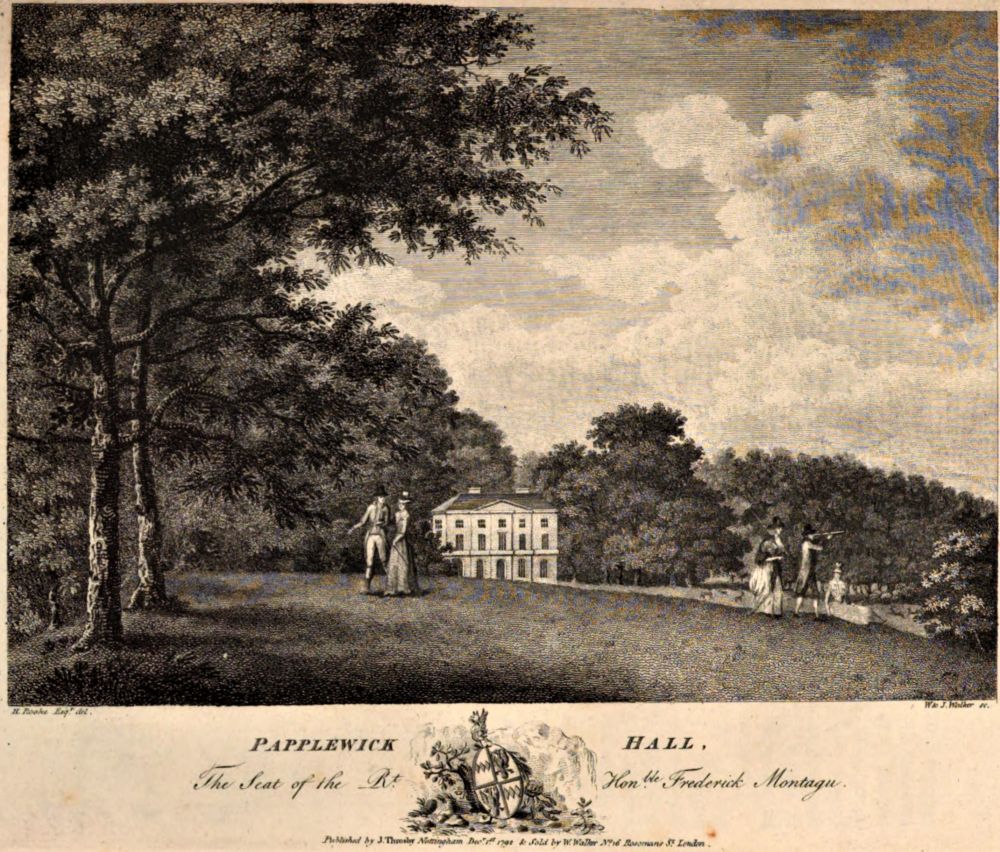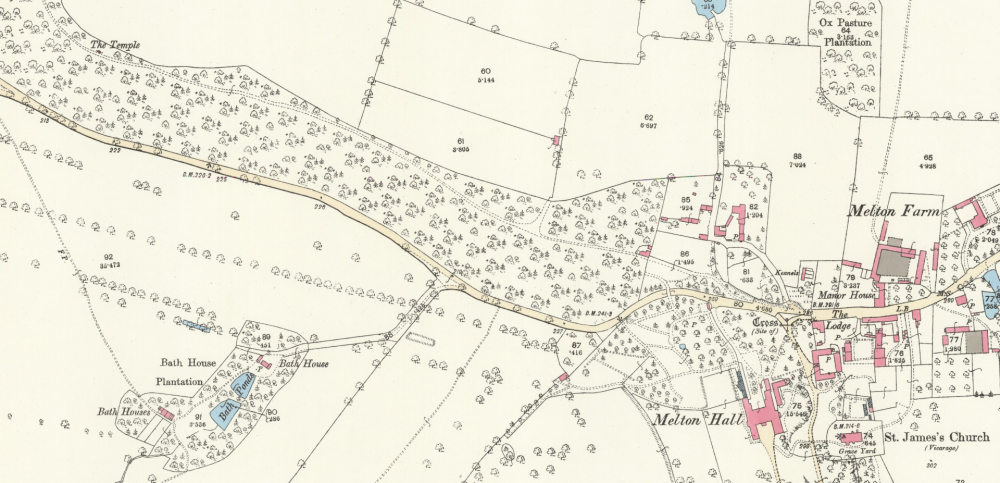Having joined YGT’s Research and Recording group in mid 2019, guided by Louise Wickham, High Melton was my introduction to South Yorkshire’s landscapes and gardens near Doncaster. Louise had warned that archive material was rather thin on the ground and so it proved to be. However, it is often the merest snippets of information which come to light, which are a cause of either much frustration or occasional celebration, as I have experienced in course of the High Melton research.

The early complex history of the ownership of High Melton (unravelled by Louise) becomes easier to access when it passes into the Fountayne family in 1651. The first high profile family member was John Fountayne IV (1715-1802) who became Dean of York. Inheriting an already established designed landscape immediate to the hall and in the wider estate (earlier than suggested by previous research), the following fleeting reference in a letter suggests that the Dean had some interest in horticultural matters:
York Dec 20th 1749
I hope you will give me leave now to thank you ... for your cuttings of your vines, of which I have given notice to my Gardener at Melton. I hope to entertain you and Lady Anne there with some of your fruit of them (Northampton Archives, F (M)G/797)
Whilst the lack of any further detail is frustrating, what is interesting is who John Fountayne was writing to. Francis Godolphin (2nd Baron Godolphin) owned Baylies [now Baylis Park], Buckinghamshire and his 2nd wife, Lady Anne (Fitzwilliam), later developed the gardens on the estate (see https://bucksgardenstrust.org.uk/wp-content/uploads/2018/09/Baylis_Park-Slough.pdf). Were there any other exchanges of plant material or design ideas? Also the Dean’s interest in improving the garden pre-dates his remodelling of the Hall (by James Paine in the 1750s). This reference is frustrating in being one of the very few specific horticultural references in High Melton’s long history.
Another more tantalising connection emerges with the fact that William Mason (1724-1797), poet and garden designer, had professional and personal links to John Fountayne over a period of 40 years through the Dean’s marriage to Ann Montagu of Papplewick, Nottinghamshire. The Historic England listing information (https://historicengland.org.uk/listing/the-list/list-entry/1001084) describes Papplewick (which passed to the Fountayne family in 1800) as
An C18 landscape park and pleasure grounds forming the setting of a late C18 house. The design for the parkland was possibly influenced by the owner’s friends, William Mason, Thomas Gray, Horace Walpole and Mrs Delaney.

It is tempting to speculate that the Fountayne-Mason link may have offered the potential for William Mason to discuss and even influence John Fountayne’s plans for High Melton Hall and gardens but frustratingly, research to date has not been able to confirm any such involvement. So any information that anyone may come across on their garden research travels relating to this, would be greatly appreciated.
The Temple is a feature of the wider Melton estate beyond what would have been the pleasure gardens. It is in the hillside wooded area known as Melton Warren, at the western end of the village of High Melton. Information about who, when and why the Temple was built has not survived. No reference is made to the Temple in either the 1840 tithe map records nor on the 1st edition 6” OS map (surveyed between 1848 and 1850) although a long walk or ride through Melton Warren is clearly marked. It is not until the 1st edition 25” OS map below (surveyed in 1890) that the Temple’s precise location is recorded and identified for the first time. Therefore it is only possible to broadly speculate that the Temple was built between 1849 and before 1890.

One of the highlights of the High Melton research was one of those ‘happy accidents’ which the British Newspaper Archive frequently provides. The uninspiring search term ‘High Melton Woods’ generated a tiny nine line report buried in a column of editorial ‘fillers’ in the Hull Daily Mail published on Friday the 23rd of March 1928. It reported an extraordinary discovery made during the demolition of High Melton Woods for building purposes, which:
brought to light an old building standing high up on the hillside which for centuries has been hidden from view by the surrounding trees. It is in the form of a small church, though it is hardly large enough to hold a dozen people. The entrance is a Gothic Arch (Hull Daily Mail, 23 March 1928)
This eye-witness account is the only surviving physical description of the Temple which has come to light, before its further deterioration and remains noted by Klemperer in 2010 (Klemperer, M. 2010. Style and Social Competition in the Large Scale Ornamental Landscapes of the Doncaster District of South Yorkshire. C. 1680-1840. Oxford, Archeopress).
Whilst completing the High Melton report, I decided to have one final search of the British Newspaper Archive for any information about the Temple and hit the jackpot. A letter from a Mr Worsley, the land agent for the Melton Estate, appeared in the Mexborough and Swinton Times on the 6th April 1928, which began ‘Referring to the photograph and comment which appeared in the current issue of your paper’. After trawling through the previous week’s edition of this weekly publication there it was, a grainy, poorly scanned image of the Temple, its first sighting for almost a century. Along with other information from the land agent, the mystery of the Temple’s possible history is now a little clearer (see the report on High Melton).
After I had finished the report, I attended an exhibition of documents relating to garden history at the North Yorkshire County Record Office, Northallerton in November last year. There I spotted a letter from the Swinton Park archive (ZS collection). It was from Adam Mickle junior (c. 1747 - 1811), the garden designer of Bedale, who was writing to William Danby, Swinton’s owner, updating him on the garden work being carried out. The letter dated 5 May 1805 included the following:
Well I am leaving home next week. One Place I am going to I find is an Acquaintance of yours. It’s to Melton. Mr R.F. Wilson. I was there as I came from London.
How interesting! Mr R. F. Wilson was Richard Fountayne Wilson who had inherited the estate from his grandfather, John Fountayne, in 1802. He was 19 at the time and so presumably had come into his inheritance the year before this letter. Although High Melton’s landscape was clearly laid out, no designer has been attributed to it. Perhaps Mickle, who worked at other estates in Yorkshire, may have advised the young man…
The valuable research lessons to be learned were:
- Keep trying different permutations of search terms
- The British Newspaper Archive response to the above can be unpredictable
- Never give up and be patient
Undaunted by the apparent dearth of archive material relating to High Melton and its history, the belief that there is more information ‘out there’ somewhere, just waiting to be discovered, is sufficient motivation to continue the search and to weather the frustrations and relish the celebrations along the way.
